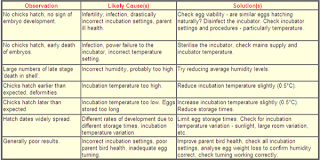Incubation Troubleshooting : Enhanced Info
Poor hatching results are frustrating and often confusing due to the large number of factors involved. The most common are given below.
 It is important to glean as much information from the hatching results as possible to enable the problem to be analysed in detail. Record dates that eggs are set, incubator settings, dates of hatches, weight losses and the number and condition of hatchings. Candle or break open unhatched eggs to estimate the extent of embryo development.
It is important to glean as much information from the hatching results as possible to enable the problem to be analysed in detail. Record dates that eggs are set, incubator settings, dates of hatches, weight losses and the number and condition of hatchings. Candle or break open unhatched eggs to estimate the extent of embryo development. As can be seen from the table, most of the symptoms listed above are caused by
a small number of problems.
Temperature - Always follow the manufacturers' guidelines: different incubators will require the thermometers to read different temperatures depending on their design. If in doubt replace the thermometer to check accuracy of the readings.

Infection - If you are getting poor results it is particularly important to maintain good hygiene within the incubator. Thoroughly clean the inside of the cabinet and all parts with a disinfectant solution. Again, follow the manufacturers' guidelines and make sure electrical parts are kept dry.
Humidity - Ideally weigh the eggs to monitor weight loss. Aim for about 13-15% (or more for some altricial species) loss during incubation and alter the humidity level to compensate for too much or too little weight loss.
Egg viability - When eggs do not hatch consistently the incubator or incubation technique is usually blamed but it is essential that the eggs set are viable. The parent birds must be healthy, not too young, old or in-bred if good hatch rates are going to be achieved.

1 comments:
njkyu28vv
golden goose outlet
golden goose outlet
golden goose outlet
golden goose outlet
golden goose outlet
golden goose outlet
golden goose outlet
golden goose outlet
golden goose outlet
golden goose outlet
Post a Comment